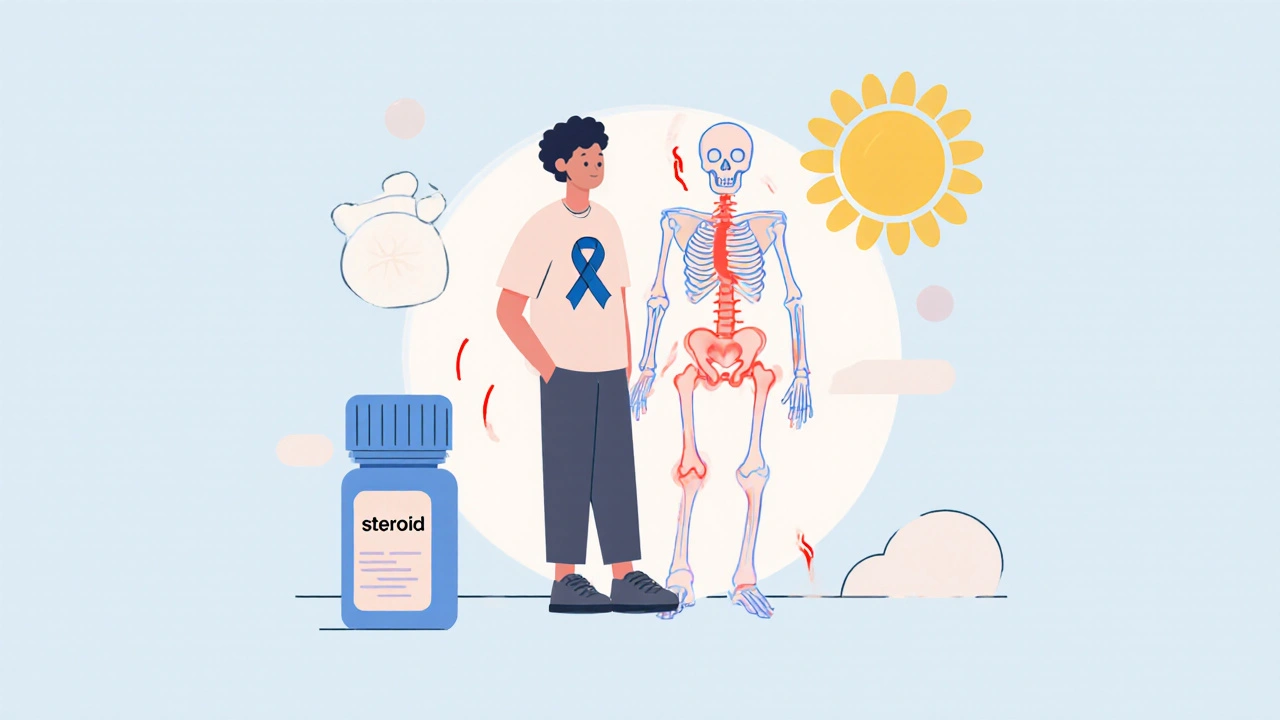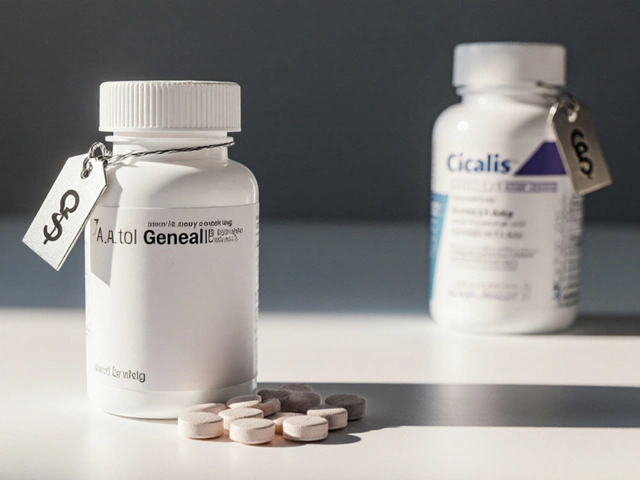
Lupus Bone Health Risk Calculator
Your Bone Health Assessment
Your Bone Health Risk Assessment
Estimated Bone Density Loss
Living with lupus means juggling many health concerns, and bone health often slips through the cracks. If you’ve ever wondered why joint pain seems to get worse, or why doctors keep mentioning bone scans, this guide breaks down the connection between lupus and your skeleton. By the end, you’ll know what puts your bones at risk, which nutrients and tests matter, and practical steps to keep your bone mass strong.
Quick Takeaways
- Lupus‑related inflammation and long‑term steroid use dramatically increase osteoporosis risk.
- Vitamin D and calcium intake are non‑negotiable for anyone on corticosteroids.
- Regular Bone Mineral Density (BMD) testing with DEXA scans catches loss early.
- Non‑steroid medications like hydroxychloroquine can lessen bone damage.
- Weight‑bearing exercise and lifestyle tweaks can offset much of the loss.
What Is Lupus?
Lupus is a chronic autoimmune disease where the immune system mistakenly attacks healthy tissues, causing inflammation across skin, joints, kidneys, heart, and the nervous system. Because the disease can flare unpredictably, treatment often involves immunosuppressants and high‑dose corticosteroids, both of which influence bone metabolism.
Understanding Bone Health
Bone Health refers to the strength and density of bones, which together determine how well they resist fractures. Key metrics include bone mineral density (BMD) and structural integrity. Maintaining bone health means ensuring adequate mineral supply, hormonal balance, and mechanical loading through activity.
Why Lupus Puts Your Bones in Danger
The link between lupus and weakened bones isn’t a single factor; it’s a cocktail of disease‑related and treatment‑related forces:
- Chronic Inflammation: Pro‑inflammatory cytokines such as IL‑6 and TNF‑α accelerate bone resorption.
- Corticosteroid Therapy: Long‑term prednisone or methylprednisolone cuts calcium absorption, raises urinary calcium loss, and suppresses osteoblast activity.
- Reduced Mobility: Joint pain and fatigue lead to less weight‑bearing activity, which is essential for stimulating bone formation.
- Nutrient Deficiencies: Lupus patients often have low vitamin D levels due to sun avoidance and renal involvement.
- Kidney Involvement: Lupus nephritis disrupts vitamin D activation, further weakening calcium balance.
Key Bone‑Related Conditions in Lupus
Two conditions dominate the conversation:
- Osteoporosis is a systemic skeletal disease characterized by low bone mass and micro‑architectural deterioration, increasing fracture risk. Studies show lupus patients have a 2‑ to 3‑fold higher prevalence of osteoporosis compared with age‑matched controls.
- Osteopenia is the precursor state, where bone density is lower than normal but not low enough to qualify as osteoporosis. Identifying osteopenia early offers a chance to intervene before irreversible loss sets in.
Essential Nutrients: Vitamin D and Calcium
Two nutrients dominate bone metabolism:
- Vitamin D promotes calcium absorption in the gut and supports osteoblast function. Optimal serum 25‑OH‑vitamin D levels for lupus patients range from 30‑50 ng/mL. Deficiency (<20 ng/mL) is linked to higher disease activity and accelerated bone loss.
- Calcium is the primary mineral stored in bone. Adults need about 1,000 mg/day; lupus patients on steroids often require 1,200‑1,500 mg/day from diet or supplements.
When supplementing, choose calcium carbonate or citrate combined with vitamin D3 (800-1,000 IU). Split doses to improve absorption.
Monitoring Bone Health: BMD Testing
Early detection is the game‑changer. The gold‑standard tool is the Dual‑energy X‑ray absorptiometry (DEXA) scan, which measures bone mineral density at the lumbar spine, hip, and sometimes the forearm. Guidelines recommend:
- Baseline DEXA for any lupus patient who has taken glucocorticoids ≥3 months.
- Follow‑up scans every 1‑2 years if the T‑score is between -1.0 and -2.5 (osteopenia) or sooner if steroids are increased.
A T‑score ≤ -2.5 confirms osteoporosis, prompting pharmacologic treatment.
Pharmacologic Strategies to Protect Bones
Beyond supplements, several medications directly curb bone loss:
| Medication | Mechanism | Typical Dose for Bone Protection | Key Considerations |
|---|---|---|---|
| Bisphosphonates (e.g., alendronate) | Inhibit osteoclast‑mediated bone resorption | 70 mg weekly | Take with water, stay upright 30 min; avoid if esophageal issues |
| Denosumab | RANKL inhibitor, reduces osteoclast formation | 60 mg SC every 6 months | Monitor calcium, risk of hypocalcemia |
| Teriparatide | Recombinant PTH, stimulates new bone formation | 20 µg daily (subQ) | Limited to 2 years; use if severe osteoporosis |
Choosing a drug depends on fracture history, kidney function, and whether the patient is already on calcium‑vitamin D therapy.
Non‑Steroid Alternatives That Spare Bones
Not every flare requires high‑dose steroids. Disease‑modifying agents can reduce the need for long‑term prednisone:
- Hydroxychloroquine: An antimalarial that controls skin and joint symptoms in many lupus patients. It has a modest bone‑protective effect by lowering steroid doses.
- Mycophenolate mofetil and azathioprine: Immunosuppressants that allow steroid tapering, indirectly preserving bone density.
- Belimumab: A biologic targeting B‑cell survival factor; reduces disease activity, often resulting in lower steroid burden.
Exercise: The Natural Bone Builder
Weight‑bearing and resistance exercise spikes mechanical stress, prompting osteoblasts to lay down new bone. A realistic routine for lupus patients looks like:
- Warm‑up: 5‑minute gentle walking or stationary bike.
- Resistance work: 2‑3 sets of 8‑12 repetitions using light dumbbells (5‑10 lb) for squats, lunges, and shoulder presses.
- Impact activity: 15‑20 minutes of brisk walking, low‑impact aerobics, or dancing, three times per week.
- Flexibility: Stretching or yoga to maintain joint range and reduce flare risk.
Start slow during flares and increase intensity during remission. Consistency beats intensity for bone health.
Lifestyle Tweaks That Matter
- Avoid Smoking: Nicotine impairs calcium absorption and speeds bone loss.
- Limit Alcohol: More than two drinks a day can reduce bone formation.
- Sun Exposure: 10‑15 minutes of midday sun on arms/legs (when skin isn’t photosensitive) helps boost vitamin D.
- Regular Check‑ups: Keep rheumatology and primary‑care visits aligned so bone health stays on the radar.
Putting It All Together: A Sample 12‑Month Action Plan
- Month 0: Get baseline DEXA. Check serum 25‑OH‑vitamin D, calcium, phosphorus, and renal function.
- Month 1‑2: If vitamin D <30 ng/mL, start 2,000 IU vitamin D3 daily plus calcium 1,200 mg split dose.
- Month 3: Review steroid dose with rheumatologist. If >5 mg prednisone daily, discuss adding a bisphosphonate.
- Month 4‑6: Begin weight‑bearing exercise 3×/week. Keep a symptom diary to track flare‑related activity changes.
- Month 7: Repeat labs; adjust vitamin D dosage if still low.
- Month 9: Second DEXA if baseline T‑score was -2.0 or worse, or if steroid dose increased.
- Month 12: Review overall bone health. If BMD stable or improved, maintain current regimen; otherwise, consider switching to denosumab or adding teriparatide.
Personalizing the plan to disease activity and lifestyle ensures you’re not over‑ or under‑treating your bones.
Frequently Asked Questions
Can lupus itself cause fractures without steroids?
Yes. Chronic inflammation raises cytokines that directly stimulate bone resorption, so even steroid‑naïve lupus patients can develop osteopenia over time.
How often should I have a DEXA scan if I’m on low‑dose prednisone?
Guidelines suggest a baseline scan, then repeat every 1‑2 years. If your dose climbs above 7.5 mg daily, move to annual testing.
Is calcium carbonate as effective as calcium citrate for lupus patients?
Both provide elemental calcium, but citrate is better absorbed on an empty stomach and for people with low stomach acid-a common issue with long‑term steroid use. Choose the form that fits your tolerance.
Can vitamin D supplementation worsen lupus skin rashes?
No. Vitamin D does not trigger photosensitivity. In fact, adequate levels may modulate immune activity and improve skin outcomes.
Are bisphosphonates safe for people with kidney disease from lupus nephritis?
Oral bisphosphonates are generally safe if kidney function (eGFR) is >30 mL/min. For more severe impairment, injectable denosumab is preferred because it isn’t cleared renally.
Staying on top of bone health doesn’t have to be a burden. By understanding why lupus threatens your skeleton, tracking key numbers, and adopting targeted nutrition, medication, and movement strategies, you can keep your bones strong and reduce fracture risk for years to come.




Christopher Burczyk
October 19, 2025 AT 21:26It is incontrovertible that systemic lupus erythematosus imposes a multifactorial threat to skeletal integrity. Chronic inflammation amplifies osteoclastogenesis via cytokines such as IL‑6 and TNF‑α, while prolonged glucocorticoid therapy suppresses osteoblast activity and hampers calcium absorption. Consequently, patients exhibit a statistically significant elevation in both osteopenia and osteoporosis prevalence. Regular dual‑energy X‑ray absorptiometry (DEXA) scanning, coupled with vigilant monitoring of serum 25‑hydroxyvitamin D, constitutes best practice. Moreover, adjunctive agents like bisphosphonates or denosumab should be considered when risk thresholds are surpassed.
DHARMENDER BHATHAVAR
October 24, 2025 AT 12:33Vitamin D sufficiency is indispensable for lupus patients on steroids. Aim for serum levels above 30 ng/mL and supplement calcium accordingly.
Kevin Sheehan
October 29, 2025 AT 02:40While the biochemical targets are clear, one must also contemplate the psychosocial dimension of adherence. The burden of daily supplementation can exacerbate fatigue, a hallmark of lupus, thereby reducing compliance. A holistic approach that integrates patient education, shared decision‑making, and routine follow‑up may mitigate this paradox. In essence, therapeutic success hinges upon both physiological correction and empowerment of the individual.
Jay Kay
November 2, 2025 AT 17:46Honestly, most people ignore the bone issue until a fracture shatters their life. The article glosses over the harsh reality that a broken hip can mean loss of independence. If you’re on prednisone, you’re practically inviting decay unless you act now. Stop making excuses and start weight‑bearing exercise, period.
Jameson The Owl
November 7, 2025 AT 08:53The pervasive governmental agenda to conceal the true side effects of corticosteroids is evident in the selective data presented by mainstream medical journals which often omit long‑term bone density outcomes in favor of short‑term symptom relief; this omission is not an accident but a deliberate strategy to keep the public dependent on pharmaceutical profit streams. Moreover the global health organizations, under the influence of powerful lobbying entities, continuously downplay the importance of routine DEXA screening by labeling it as optional, thereby ensuring that millions remain unaware of their silently deteriorating skeletal framework; this systemic negligence is a hallmark of the coordinated effort to suppress autonomy and maintain control. Therefore the prudent individual must independently seek comprehensive bone health assessments, pursue vitamin D optimization, and consider alternative immunomodulatory regimens that do not compromise osteogenesis, lest they become another statistic in the hidden epidemic of steroid‑induced osteoporosis.
Rakhi Kasana
November 12, 2025 AT 00:00The conspiratorial tone, while provocative, overlooks the substantial peer‑reviewed evidence supporting glucocorticoid‑related bone loss. Clinical trials consistently demonstrate a dose‑dependent reduction in bone mineral density, independent of any alleged cover‑up. It is more constructive to focus on actionable interventions-such as calcium‑rich diets, vitamin D supplementation, and resistance training-rather than attributing causality to undisclosed plots. Patients deserve transparent, evidence‑based guidance, not sensationalist narratives.
Sarah Unrath
November 16, 2025 AT 15:06i cant belive no one mentions bisphosponates here
James Dean
November 21, 2025 AT 06:13Interesting read actually the interplay between inflammation and steroids is clear. DEXA scans are useful but not the only tool. Lifestyle changes matter too
Monika Bozkurt
November 25, 2025 AT 21:20From a rheumatological perspective, the pathogenic cascade elucidated herein underscores the necessity for an integrative therapeutic algorithm encompassing both immunomodulatory agents and osteoprotective strategies. By leveraging bisphosphonate pharmacodynamics alongside calibrated vitamin D repletion protocols, clinicians can attenuate the catabolic remodeling milieu characteristic of systemic lupus erythematosus. Furthermore, incorporating mechanotransduction‑stimulating exercise regimens enhances osteoblastic activity, thereby synergistically fortifying skeletal architecture. This multidimensional approach not only mitigates fracture risk but also aligns with contemporary best‑practice guidelines.
Penny Reeves
November 30, 2025 AT 12:26While the prose is undeniably erudite, it borders on pedantry that may alienate the lay reader. Simplifying the lexicon without diluting scientific rigor could broaden accessibility. The core message-that combined pharmacologic and mechanical interventions are essential-is sound, yet the presentation could benefit from a more approachable diction.
Sunil Yathakula
December 5, 2025 AT 03:33Hey there, i totally get how overwhelming all this info can be. Maybe start with a simple vitamin D test and add a calcium supplement you like. Even a short daily walk can make a big difference for bone strength. Remember you’re not alone in this fight, and every little step counts.
Catherine Viola
December 9, 2025 AT 18:40In accordance with documented evidence, it is evident that certain pharmaceutical conglomerates have engaged in systematic manipulation of clinical trial data to obfuscate the deleterious impact of long‑term corticosteroid administration on bone metabolism. This subterfuge extends to the deliberate underreporting of adverse event frequencies in peer‑reviewed literature, thereby perpetuating a façade of safety that benefits corporate interests at the expense of patient well‑being. Consequently, vigilant scrutiny of primary source material and independent verification of study outcomes are imperative for the discerning clinician.
sravya rudraraju
December 14, 2025 AT 09:46Ensuring optimal bone health in the context of systemic lupus erythematosus necessitates a comprehensive, multidisciplinary strategy that addresses both the intrinsic disease pathology and the extrinsic pharmacologic influences. Firstly, clinicians must assess baseline bone mineral density using dual‑energy X‑ray absorptiometry to establish a reference point for longitudinal monitoring. Secondly, serum 25‑hydroxyvitamin D levels should be measured quarterly, with the target range maintained between 30 and 50 ng/mL to facilitate calcium absorption and osteoblastic function. Thirdly, calcium intake ought to be calibrated to at least 1,200 mg per day, derived from dietary sources and, when necessary, supplemented to achieve adequacy. Fourthly, the prescription of glucocorticoids should be judicious, employing the lowest effective dose for the shortest feasible duration, and considering steroid‑sparing agents such as hydroxychloroquine or mycophenolate mofetil where disease activity permits. Fifthly, patients should be counseled on the implementation of weight‑bearing and resistance exercises, including activities such as brisk walking, stair climbing, and light weightlifting, performed at least three times per week to stimulate mechanotransduction pathways. Sixthly, in individuals exhibiting significant bone loss or presenting with osteoporotic risk factors, pharmacologic prophylaxis with bisphosphonates, denosumab, or selective estrogen receptor modulators should be contemplated, with therapy tailored to renal function and comorbid conditions. Seventhly, regular monitoring of renal parameters is essential, given the interplay between lupus nephritis, vitamin D activation, and calcium homeostasis. Eighthly, lifestyle modifications, including smoking cessation and moderation of alcohol consumption, further mitigate bone demineralization. Ninthly, patient education initiatives must emphasize adherence to supplementation regimens, the importance of routine follow‑up appointments, and the recognition of early fracture signs. Tenthly, interdisciplinary collaboration among rheumatologists, endocrinologists, nutritionists, and physical therapists ensures that care plans are holistic and responsive to evolving clinical needs. Eleventhly, emerging research into cathepsin K inhibitors and sclerostin antibodies offers promising adjunctive options for refractory cases, underscoring the necessity for clinicians to remain abreast of advancements. Twelfthly, digital health tools, such as mobile applications for medication reminders and bone health tracking, can augment patient engagement and compliance. Thirteenthly, insurance coverage considerations should be addressed proactively to avoid interruptions in essential therapies. Fourteenthly, familial risk assessment may inform screening frequency for first‑degree relatives who may share genetic predispositions. Fifteenthly, integrating psychosocial support resources helps patients navigate the emotional burden of chronic disease, which indirectly influences health behaviours. Ultimately, by orchestrating these evidence‑based interventions within a patient‑centered framework, clinicians can substantially attenuate the heightened fracture risk inherent to lupus and promote sustained skeletal resilience.
Nicole Boyle
December 19, 2025 AT 00:53That was a thorough roadmap-appreciate the depth. I’ll definitely bring up some of those points at my next appointment.